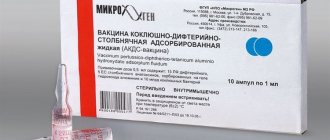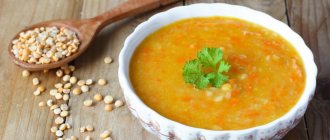How long after vaccination can complementary foods be introduced: reasons and rules, risks - Baby
As you know, during the first year of life, a baby receives a huge number of vaccinations necessary to form an immune response against most infectious diseases dangerous to the child’s body.
This time is parallel to the period when the baby begins to get acquainted with the first food products, which gradually fill his diet. It is no secret that doctors recommend introducing all complementary foods gradually, starting with minimal quantities.
This is how you can prevent the development of allergies in a child or other disorders associated with the entry of unfamiliar substances into the baby’s body. Therefore, many mothers are interested in whether it is possible to combine the introduction of complementary foods with vaccination? Is this practice dangerous to the health of the baby?
How to introduce new foods into complementary feeding for a baby after vaccination?
Breastfeeding and the use of adapted formulas cannot last forever - sooner or later the moment of the first complementary feeding comes. Where to start and how exactly to introduce the baby to new foods is decided by the mother after consultation with the pediatrician. There is another problem associated with the introduction of unfamiliar products - how to combine complementary feeding and routine vaccinations.
Features of complementary feeding
By the time complementary foods can be introduced, the baby has received most of his vaccinations. Therefore, some mothers calm down and sincerely believe that they know exactly the future reaction of the baby. But this does not mean that you can expose your baby to danger and combine a new product with vaccination.
Depending on the weight and well-being of the baby, the pediatrician will advise when and how much to give a new product. For small children, porridge is preferable; for overweight toddlers, complementary foods made from fruits can be introduced.
Before introducing adult food, the pediatrician examines the child, asks the mother about the baby’s mood and stool frequency, after which a decision is made on the composition of complementary foods. The same manipulations are carried out before vaccination.
The start of complementary feeding should not coincide with the baby’s illness or the rehabilitation period after a cold. The new product should be introduced carefully and in small portions, starting with ½ teaspoon.
The second morning feeding is ideal to observe the baby's reaction and note the slightest changes in his behavior and well-being.
In addition, in the morning, food is digested better, and the baby is in a good mood and ready for discoveries.
First, a little complementary feeding is offered, after which the baby is fed with breast milk or formula - there is no need to insist on how much he eats. The baby may refuse unfamiliar food, but you should not insist. It is better to be patient and try giving the product after a few days. A reaction to food may occur in the form of:
- changes in stool consistency
- stomach upset
- skin rash
In normal health, the volume of the new product is increased to 1 teaspoon and gradually increased to 200 g. If negative symptoms occur, it is necessary to stop introducing the allergenic product.
Effect of vaccinations
A vaccine is introduced into the child's body, and the response to it is the production of antibodies by the immune system. Vaccinations have their own timing, administration mechanism and schedule - and the body reacts differently to each vaccine. Any vaccination may be accompanied by:
- lethargy
- refusal to eat
- drowsiness
- elevated temperature
Children tolerate some vaccines with enviable ease, while others are accompanied by an acute reaction and deterioration of the child’s condition, like DTP. Moreover, an unpredictable reaction may occur to the same vaccine administered at different times.
Parents confuse the concept of reaction to a vaccine with complications after it, the latter include:
- loss of consciousness
- increase in body temperature above 40 C
- convulsions
- the appearance of suppuration
Vaccination rules recommend:
- Do not vaccinate in acute painful conditions - in this case, even routine vaccination can be postponed by changing the schedule.
- At the time of vaccination, the baby should not have diarrhea, fever, runny nose or rash.
- If the child has a history of allergic reactions, the pediatrician will prescribe an antiallergic drug before vaccination. You should not give anything to your baby on your own without consulting a doctor, even if the drug helped the child of a relative or friend.
Similar recommendations are present when introducing complementary foods, so we can draw a conclusion about the relationship between vaccinations and familiarity with a new product.
Vaccine and complementary feeding
It is impossible to introduce a new product either immediately before or after vaccination. It is necessary to take a seven-day break - in other words, a week before vaccination and a week after, gastronomic experiments are not allowed.
The famous pediatrician Oleg Evgenievich Komarovsky advises reducing the period to 3 days before and after vaccination. Any mother is an overinsurer and would prefer to endure a longer period in order to avoid negative consequences and complications.
The vaccine triggers the body's hidden reserves, forcing the immune system to work in enhanced mode. And if a new product is introduced at this stage, one can only guess about the reaction of a fragile organism.
The stomach and intestines must adapt to the unfamiliar consistency of food; the body must digest the received food by turning on additional mechanisms. Negative reactions to complementary feeding are common, after which the mother decides to postpone introduction to the product until a more favorable time.
At the same time, the symptoms of rejection of a new food can easily be confused with a reaction to a vaccine. This is considered one of the reasons why pediatricians advise introducing complementary foods at least a week after vaccination.
The second reason is the excessive load on the child’s body, especially if it is planned to carry out DTP.
The gastrointestinal tract must “come to its senses” in order to digest adult food, so another blow in the form of a vaccine will certainly lead to failure.
Parents should find out in advance about the timing of vaccination or revaccination (as in the case of DTP), so that a visit to the pediatrician does not become an unexpected surprise. You can introduce complementary foods 10 days before the next vaccination, after which you can monitor the child’s condition for 3 days. And then feel free to go get the vaccine, since the baby’s body will have time to rest between the stress on the gastrointestinal tract and immune system.
Baby's first complementary foods: how to introduce them correctly?
There comes a time in every mother’s life when it’s time to introduce complementary foods to her baby’s diet.
This process must be taken with great responsibility, because food contains vitamins and other nutrients that are necessary for an actively developing child’s body.
Therefore, in order for a child to grow up healthy, you should take into account some rules for introducing new foods into the baby’s diet.
When should you start introducing complementary foods?
Previously, it was believed that you should start letting your baby try new foods from 3 months, but now views on this have changed somewhat. Pediatricians say that the first complementary foods can be introduced starting from six months. At this age, the child’s digestive system is already “ready” to digest not only breast milk, but also other foods. Read more about introducing complementary foods while breastfeeding.
Is it possible to introduce new foods into a child’s diet after vaccination?
Pediatric experts strongly do not recommend introducing new foods either before immunization or after vaccination.
It is necessary to ensure that the break between events is at least seven days, that is, complementary foods are prohibited from being introduced a week before vaccination and for a similar period of time after it. Modern experts sometimes advise reducing the period of abstinence from new complementary foods to three days before and after vaccination.
Such measures are relevant if the child tolerates vaccinations well and does not have a tendency to develop allergic reactions. In addition, pediatricians are well aware of the habits of mothers to play it safe, and therefore they always independently extend the periods recommended by doctors.
Why can’t we combine complementary foods and vaccinations in young children? Since vaccines tend to trigger complex mechanisms in the child’s body and stimulate the immune system, they sometimes provoke the development of adverse reactions on the part of the fragile body. If at this stage you introduce a product unfamiliar to him, then you can only guess about the consequences.
Digesting the food received, the organs of the digestive tract begin to work in an enhanced mode, directing their resources to adapt to new substances. In addition, with each complementary feeding, the baby gets acquainted with a new consistency of food and its taste.
Such processes are accompanied by the release of enzymes, bile, etc. Due to the increased load, a small body does not always cope with the task and may react negatively to the introduced food products.
The time of complementary feeding should be as comfortable as possible, that is, during this period the baby should not be exposed to outside influences that reduce his reactivity.
Another reason why pediatricians do not recommend combining vaccinations and complementary feeding is that the symptoms of rejection of a new food product can easily be confused with an undesirable reaction to a vaccine.
This is especially true for DTP vaccination, which is famous for its side effects and is tolerated with the development of general malaise, moderate intoxication, lethargy, and local reactions in approximately 40% of vaccinated children.
How long after vaccination can complementary foods be introduced and why not before it?
After the child is vaccinated, parents begin to wonder how long after the first complementary foods can be introduced. Every mother should know that doctors have provided a specific procedure for weaning a child correctly from breastfeeding or adaptive formulas. To avoid making mistakes, it is recommended to undergo a consultation before the scheduled vaccination.
Is it possible to introduce complementary foods before and after vaccination?
Experienced pediatricians always warn women that complementary feeding should not be done before vaccination. This is explained by the fact that if it provokes an allergy, it will be very difficult for the child’s body to cope with the current situation. The pediatrician should inform you about this three days before the injection. For the same number of days after it, the child is prescribed to give antihistamines, for example, Zertec or Fenistil.
If on the first night after vaccination the child has a temperature above 38 degrees, he should be given an antipyretic. Panadol is good for this.
But this opinion is not unambiguous, since some parents introduced complementary foods before and after vaccination.
It is difficult to predict the reaction of the child’s body in such a situation; it all depends on the individual characteristics of the reaction of each child’s immune system.
When to start introducing the first complementary foods
There is no clear answer to the question of how much time a child’s body should be given after vaccination. Parents often say that 3 days after and before vaccination are enough. But the pediatrician sometimes advises increasing this period to 7 days if the child may suffer from complementary feeding due to the characteristics of his body.
If complications arise due to non-compliance with such rules, they may manifest themselves as follows:
- Cramps.
- Suppuration.
- Severe increase in temperature.
- Loss of consciousness.
Useful tips
When parents hear about prohibitions on vaccinations or first complementary feeding, they wonder why this cannot be done. There are several reasons. Firstly, it is worth taking into account the individual characteristics of the child’s body and its reactions to various actions before.
Speaking about the specific rules for vaccination, they are as follows:
- If a child has a history of allergic manifestations, he should be prescribed an antiallergic medication before vaccination. It is extremely prohibited to choose it yourself, even if it is recommended by friends and relatives who have successfully used one of these remedies;
- Vaccination is not carried out if the child suffers from an illness. In this case, vaccination should be postponed until the child has fully recovered;
- Before vaccination, the child should not have any symptoms of gastrointestinal disorders. First of all, this includes diarrhea. The same rule should be followed if the baby suffers from fever, body rash or runny nose.
After vaccination, it is worth introducing complementary foods in small portions. During this period, he can be supplemented with formula or breast milk.
If he doesn’t finish eating, you shouldn’t put pressure on him to refuse food that is still unfamiliar or already familiar. Parents are advised to be patient and introduce complementary feeding after 2-3 days.
If this is not done, your baby may suffer from consequences such as skin rashes, changes in stool consistency, and stomach upset.
Possible consequences of introducing new complementary foods after vaccination
Vaccination is always stressful for a fragile little organism, so doctors do not recommend giving the child new food products during the period of its administration that can provoke the development of vaccination complications.
As you know, any food can be an allergen for a baby and provoke the development of a hypersensitive reaction. This in turn will lead to additional stress on the immune system and cause it to malfunction.
Among the consequences of introducing new food products immediately after vaccination, doctors highlight:
- development of local allergic reactions in the form of an itchy rash with redness and swelling of tissues;
- the occurrence of symptoms of anaphylaxis or angioedema;
- increase in general body temperature;
- convulsions
- severe intoxication syndrome;
- fatigue, lethargy, emotional instability and moodiness.
After vaccination, the baby is allowed to introduce complementary foods only if he has already had a good taste of this product before vaccination. In other cases, new “goodies” should be abandoned for 3-7 days, depending on the child’s general well-being after vaccination.
Baby's first complementary foods: how to introduce them correctly?
There comes a time in every mother’s life when it’s time to introduce complementary foods to her baby’s diet.
This process must be taken with great responsibility, because food contains vitamins and other nutrients that are necessary for an actively developing child’s body.
Therefore, in order for a child to grow up healthy, you should take into account some rules for introducing new foods into the baby’s diet.
Technique for introducing complementary foods
After the mother has decided which product to give to the baby and has prepared it, the question arises: how to properly feed the child a new dish, how much food to give for the first time, why the baby refuses complementary foods, and so on. To avoid any difficulties, use these simple tips:
- The first portions should be very small (only 0.5 teaspoon): let the baby get used to it, because for him even a drop of unfamiliar food is something new and incomprehensible. You can gradually increase the volume of portions.
- Introduce complementary foods to your baby on an empty stomach (before breastfeeding).
- The first baby dish should consist of one ingredient.
- If the child is not hungry, do not force him to eat, be patient.
- While feeding, talk gently to the baby, but do not distract him with a variety of toys and other bright objects.
- Do not scold your child if he wants to touch a product unknown to him.
You need to feed the child by sitting him on a children's chair with a stand. This way, from childhood, the baby will learn to eat while sitting at the table.
Scheme for introducing complementary foods by month
You definitely need to know what foods can be given to your child at what age:
| 6 month | The baby is given vegetable purees from zucchini, carrots, pumpkin, cauliflower or broccoli (one ingredient is selected). |
| 7 month | Porridge without milk is introduced (rice, buckwheat, corn porridge). |
| 8 month | The child is allowed to try lean meat (chicken breast, rabbit and turkey). Boiled chicken yolks and grated potatoes are also introduced little by little. |
| 9 month | It's time to give your baby cottage cheese and baby kefir. |
| 10 month | Add fruit purees to your diet using apples and pears. |
If a child is underweight, the doctor may recommend starting complementary feeding not with vegetables, but with the introduction of cereals. As your baby grows, you can prepare separate dishes for him from the allowed ingredients (vegetable soups, stews, and so on).
Is it possible to introduce complementary foods before and after vaccinations?
Parents know that vaccinations are needed to protect the child’s body from infectious diseases. All children under one year of age are given the necessary vaccines, and often the vaccination period coincides with the time of introduction of the baby's first complementary foods. In this case, young mothers doubt: is it possible to give their child new foods before and after vaccination?
According to doctors, introducing complementary foods a week before vaccination and for a week after it is not recommended.
The fact is that after vaccination, the child’s body produces specific antibodies, and this process is often accompanied by the following symptoms:
- increased body temperature;
- local reactions: skin redness, rash, itching;
- the child becomes capricious and sleeps poorly;
- decreased appetite.
After the introduction of the first complementary foods, the baby’s digestive system must adapt to the new product, which is also a foreign substance. Often the body responds to complementary foods with allergies, the symptoms of which are very similar to the reaction to a vaccine. In such cases, it is very difficult to determine what the cause of this clinical picture is and whether treatment is necessary.
Therefore, it is better to wait with complementary foods during the introduction of preventive vaccinations, because this will preserve the baby’s health.
Is it possible to introduce complementary foods when teeth are being cut?
The answers to this question are controversial. The appearance of the first teeth is a huge stress for the child’s body, accompanied by a slight decrease in immunity. Therefore, your child may experience cold symptoms:
- temperature increase;
- runny nose;
- bowel disorders;
- general weakness and malaise, constant whims.
If complementary foods are introduced at this moment, the baby’s body can be seriously damaged. In addition, there are difficulties in identifying allergic reactions to food. To avoid putting your child's health at risk, consult your pediatrician. If the baby’s general condition is normal, then introducing new foods into the diet becomes possible.
Is it possible to introduce complementary foods when sick?
Remember: introducing complementary foods is acceptable when the child is absolutely healthy! Any infectious process is a powerful blow to the baby’s immunity. It is impossible to add new dishes to a child’s diet during illness for some reasons:
- A new product is stressful for the digestive system, which requires time to adapt to this ingredient. In a sick body, this process becomes somewhat more difficult, which can lead to deterioration in health.
- In case of illness, the child is prescribed medications that can provoke allergies. Food products may have the same properties, which makes it difficult to determine the cause of the response.
- Due to the manifestations of the disease, the baby becomes more capricious and may refuse to eat, especially if it is not breast milk.
Therefore, complementary feeding should be introduced only after the child has fully recovered, on the recommendation of a doctor.
Complementary feeding and lactose intolerance
Lactose deficiency is a condition of lack of the enzyme lactase in the child’s body, accompanied by the following symptoms:
- stool disorders (it becomes frequent and liquid);
- the baby becomes very restless after feeding;
- possible bloating;
- colic.
Children with this disorder are allowed to introduce complementary foods from 5 months, starting with vegetables. Porridges are prepared without milk; you need to exclude dairy products from the diet, replacing them with special lactose-free ones. At 6-7 months, you can give your baby some fruit juice, but this should be done with extreme caution, best after consulting a doctor.
And don’t forget: don’t rush, introduce new dishes gradually, starting with small portions. This is the only way to keep your children healthy and happy!
Natalya Korol, pediatrician, especially for Mirmam.pro
:
Where to start feeding a baby at 4 months
If the child is underweight or has unstable stools, it is better to start with cereals. Conversely, if you are overweight and prone to constipation, it is recommended to introduce complementary foods with vegetable puree. If your baby is free of such troubles and is absolutely healthy, then the advice of pediatricians and nutritionists currently boils down to starting complementary feeding with vegetable puree. But we must keep in mind that it will not be easy for a child to switch from the sweet taste of breast milk or a substitute to a completely unsweetened vegetable, so you should be patient - you will have to offer a new dish at least 10-12 times, and only after that (if the baby stubbornly refuses it ) move on to another type of vegetable.
Read also…. Food allergies in a child: photos, symptoms, causes
Attention! Bugs!
- You should not immediately switch to porridge if the child has not accepted this or that vegetable - there is a high probability that the baby will not want to eat vegetables at all after introducing sweet porridge.
- You should not additionally sweeten industrially produced cereals. It should be borne in mind that the child is just getting used to new tastes, and his future eating habits depend on how healthy he is taught to eat in the family. As a result, the habit of sweet foods can lead to obesity and related diseases.
- When buying ready-made food, you should not add additional salt or vegetable oil. Canned vegetables for children are often prepared with a small amount of salt.
What vegetables are best to start with? First of all, you should offer your baby zucchini, all types of cabbage, and potatoes - they are the least likely to cause allergies. Later you can try carrots, beets and tomatoes. The modern baby industry offers a wide range of different types of purees. According to the degree of grinding they are divided into:
- homogenized, which are offered to children from 4.5 months;
- pureed for children 6–9 months;
- coarsely ground (9–12 months).
Foreign manufacturers, trying to improve the taste of their products, use legumes (beans, peas, etc.), tomatoes and tomato paste, onions, garlic, and spices (in particular, pepper) when making vegetable purees. In this case, they recommend introducing them from 5–6 months. This does not comply with the prescriptions of domestic pediatricians and nutritionists. Such purees should not be given as complementary foods to babies aged 4–6 months.
- Tomatoes are one of the vegetables that especially often cause allergies in children - they can be introduced into the diet no earlier than six months.
- Tomato paste containing salt is best introduced from 6–7 months
- Legumes, which contain a high level of plant fibers and special types of sugars that can cause irritation of the intestinal mucosa and increased gas formation - no earlier than 7-8 months.
- Onions and garlic containing essential oils that irritate the mucous membranes of the stomach, intestines, and kidneys - only from 8–9 months
- Spices – from 9 months and older.
Read also…. 15 main parameters when choosing the ideal stroller for a newborn
But you can prepare vegetable complementary foods yourself, using both fresh and frozen vegetables. To do this, you need to boil them, then make a puree (in a blender or using a regular masher). Add a little vegetable or melted butter (no more than 3-4 grams). Butter is another new complementary feeding product that children become familiar with from the moment vegetable puree or porridge is introduced. It is a source of nutrients, energy, and fat-soluble vitamins (A, D, E).
- Vegetable oil is allowed to be introduced from 4.5 months,
- creamy - no earlier than 5-6 months.











